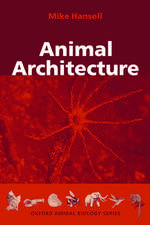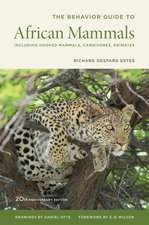Ultrasonic Communication by Animals
Autor G. Salesen Limba Engleză Paperback – 24 iun 2012
Preț: 389.70 lei
Nou
Puncte Express: 585
Preț estimativ în valută:
74.57€ • 78.06$ • 61.70£
74.57€ • 78.06$ • 61.70£
Carte tipărită la comandă
Livrare economică 07-21 aprilie
Preluare comenzi: 021 569.72.76
Specificații
ISBN-13: 9789401169035
ISBN-10: 9401169039
Pagini: 324
Ilustrații: XI, 281 p. 54 illus.
Dimensiuni: 155 x 235 x 17 mm
Greutate: 0.45 kg
Ediția:1974
Editura: SPRINGER NETHERLANDS
Colecția Springer
Locul publicării:Dordrecht, Netherlands
ISBN-10: 9401169039
Pagini: 324
Ilustrații: XI, 281 p. 54 illus.
Dimensiuni: 155 x 235 x 17 mm
Greutate: 0.45 kg
Ediția:1974
Editura: SPRINGER NETHERLANDS
Colecția Springer
Locul publicării:Dordrecht, Netherlands
Public țintă
ResearchCuprins
1. What is ultrasound?.- The discovery of animal ultrasound.- The properties of ultrasound.- 2. Methods of detection and analysis.- Ultrasonic microphones.- Cathode-ray oscilloscopes.- Tape-recording and analysis.- Bat detectors.- 3. Bats.- The biology of bats.- The echo-location signals of bats.- Short-pulse echo-location in Megachiroptera.- Frequency sweep pulses in Microchiroptera.- Constant frequencies in Microchiroptera.- Mixed signals in Microchiroptera.- Sound production and emission in Microchiroptera.- Frequency-sweep bats.- Constant frequency bats.- Nose-leaves.- Hearing in the Microchiroptera.- Other senses and social use of ultrasound in Microchiroptera.- 4. Countermeasures by insects.- Noctuidae.- The evasive behaviour of noctuid moths.- Acoustic sensitivity of the tympanic organ.- Directionality.- Central co-ordination.- Arctiidae, Notodontidae and Ctenuchidae.- Pyralididae.- Sphingidae.- Geometridae.- Neuroptera.- Evolution.- 5. The songs of bush crickets (Tettigoniidae).- The physics of strigilation in general.- The mechanism of sound production in tettigoniids.- The ultrasonic songs of tettigoniids.- The acoustic behaviour of tettigoniids.- The ability of tettigoniids to hear ultrasonic sounds.- Some further considerations.- 6. Other insects.- Gryllidae, crickets.- Gryllotalpidae, mole crickets.- Acrididae, grasshoppers and locusts.- Insects of other groups.- 7. Ultrasound in rodents.- The ultrasonic calls of infant rodents.- The physical characteristics of the calls.- The motivation for the emission of ultrasonic calls by infant rodents.- The role of infant distress calls in adult-young relationships.- Ultrasound and aggressive behaviour.- Rats.- Other myomorph rodents.- Social significance.- Ultrasound and mating behaviour.- Mice.- Rats.- Other myomorph rodents.- Social significance.- Other situations involving ultrasound emission in rodents.- The mechanism of ultrasound production in rodents.- The ability of rodents to hear high frequency sounds.- 8. Other vertebrate groups.- Birds.- Cetacea.- The sounds of odontocetes.- The site of sound production.- The ear of odontocetes.- Hearing in odontocetes.- Evidence for echo-location in odontocetes.- Other marine mammals.- Insectivora.- 9. Review and speculations.- Appendix Some formulae summarizing the rules of echo-location.- References.- Indexes.
















